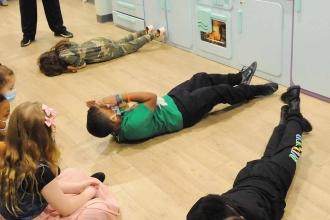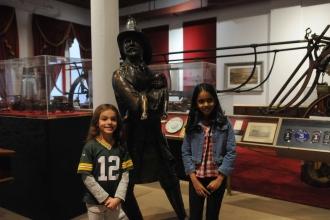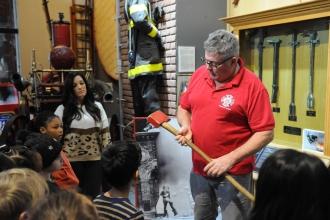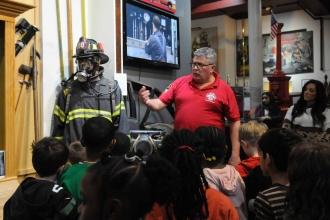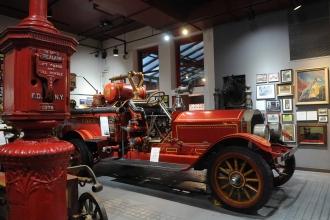All fired up!
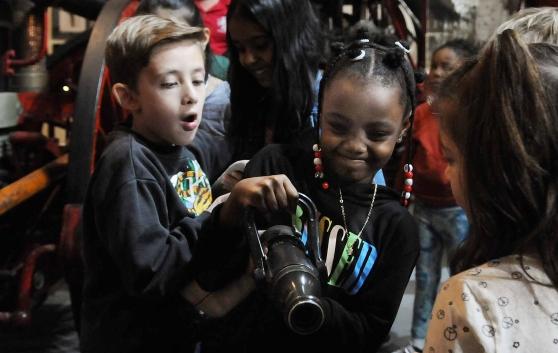
Second-graders from PS 45 in West Brighton, Staten Island, pass around a hose during a field trip to the New York City Fire Museum.
A smoke detector beeped as two dozen 2nd-graders stepped out of a bedroom and into a dark, smoke-filled kitchen at the New York City Fire Museum. They dropped to the floor and crawled, keeping their right hands on the wall to guide them to the exit. After checking to make sure the door wasn’t hot, the lead student gave the “all clear” to leave.
When the students from PS 45 in West Brighton, Staten Island, were all “safe,” they realized their teacher, Marie Campanella, was still in the mock apartment. “Who wants to go in and save her?” retired New York City firefighter Tom Sullivan asked.
A chorus of students shouted, “Me!” Only a few correctly answered, “You!”
“The only person that goes back in is the firefighter,” said Sullivan, a museum educator.
Less than a minute later, he reappeared with Campanella, and excited children yelled, “She’s out, she’s out!”
That was one of the highlights of the Jan. 6 field trip to the New York City Fire Museum, a renovated Beaux-Arts building on Spring Street in SoHo in Manhattan that once housed Engine Co. 30. Campanella, a New York City public school teacher for 11 years in Brooklyn and on Staten Island, has taken many students to visit the museum over the years. The smoke and the “escape” were the best parts of the visit, according to some of her students.
It was the third field trip this school year for Campanella’s Gifted and Talented class — and the students’ favorite so far.
“Students need to know there is a bigger world outside the classroom where they can make connections to what they are learning inside the classroom,” she said. “Trips give more meaning to the entire learning experience.”
The fire museum ties in with PS 45’s curricular theme of community, which involves researching and learning about essential places within communities. It also connects with an upcoming social studies unit called “Then and Now” about the history of New York, she said.
A fire on Staten Island on Dec. 23, 2022, that took the lives of three young siblings was a reminder of how important fire safety is, Campanella said.
The students started their visit with a fire safety video and received a homework assignment to check that their houses and apartments have working smoke detectors with good batteries. They learned key catchphrases, such as “fall and crawl” and “don’t hide, go outside.”
The museum is hands-on, giving visitors opportunities ranging from handling leather buckets like those that colonial-era New Amsterdam residents used, to experiencing the mock apartment with its special-effects smoke and black-lit fire and burn hazards.
Students saw the progression of firefighting from bucket brigades to hand-drawn pumpers to horse-drawn steam engines to the motorized trucks that ultimately led to today’s engine, ladder, rescue and squad vehicles. During that time, the Fire Department of New York evolved from a volunteer to a paid workforce.
The children had a lot of questions for the museum educators: Who was the first female firefighter? What if a window was stuck when they were trying to escape? Would they ever have to jump from a balcony to escape a fire?
“But who rescues the pets?” 2nd-grader Abby wanted to know.
“Sometimes pets get out on their own,” Sullivan said. “Firefighters worry about people first.”
Sullivan explained that firefighters do more than just fight fires, such as responding to accidents, to people stuck in elevators or to gas leaks and other emergencies. He showed some of the tools they use to open locked doors, poke holes in walls, take down a ceiling or extract a passenger from a car after a serious accident.
Retired firefighter Harriett Duren, another museum educator, made sure students knew their stuff about smoke detectors, cooking hazards, why candles are dangerous and how to stop, drop and roll if their clothes are on fire.
Duren told the students that most fires occur between 10 p.m. and 6 a.m., when people are asleep. “It’s a very, very important part of why a smoke detector has to be so loud and noisy when it goes off,” she said.
Duren has a distinction some of the students were particularly interested in: She was one of 41 women in the first class of female recruits in the Fire Department in 1982. “We have about 136 women on the job right now,” she said. “You girls can be firefighters.”
The New York City Fire Museum, located at 278 Spring St. in Manhattan, offers hour-long fire safety education tours for 15 to 40 people, including both children and adults. Advance reservations are needed. For more information, visit www.nycfiremuseum.org/fire-safety-education.
